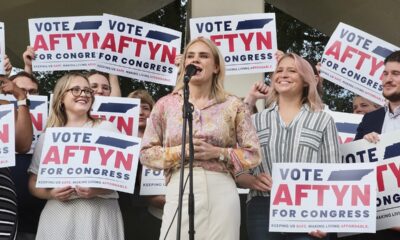California
How a So. California Democrat hopes to become Little Saigon’s first Vietnamese House member
House stops Marjorie Taylor Greene’s efforts to oust Speaker Johnson
Members of Congress from both parties react to Rep. Marjorie Taylor Greene’s failed attempt to oust House Speaker Mike Johnson on Wednesday.
WESTMINSTER, CA – On a cloudy recent holiday morning, as dozens of people who served in the South Vietnamese army mingled after honoring the memories of those who died in the Vietnam War, one veteran called out to his friends to “meet Derek!”
That would be Derek Tran, a micro-celebrity of sorts in Southern California’s Vietnamese community who posed for Memorial Day selfies and shook hands with people interested in meeting the Democratic candidate for an Orange County-based U.S. House seat that his party sees as a critical part of its pathway to winning back the majority in November. The area he’s running to represent is home to Little Saigon, a district with one of the largest Vietnamese populations outside of Vietnam itself.
Despite that claim to fame, Southern California’s Little Saigon has never been represented by a Vietnamese American in federal office.
“It’s weird. It’s not something I’m used to,” Tran, who is Vietnamese, told USA TODAY of his newfound popularity as he made his way around a local park that features two towering statues of American and South Vietnamese soldiers standing side by side, flanked by their respective flags.
“But I take a lot of pride in their excitement about my race, so I take it as it comes,” he added. “They’re appreciative and they are just happy to have someone … that’s going be able to possibly give us a voice in Congress.”
Tran, a 43-year-old political newcomer who previously worked as a lawyer for personal injury and discrimination cases and served in the U.S. Army, is running a campaign in one of the nation’s few competitive House races in the upcoming elections that will determine which party will control the lower chamber and play a major role in shaping or killing the agenda for the White House winner. Highlighting the competitiveness of Tran’s race, it’s one of the handful of districts that President Joe Biden won in the 2020 election but is held by a Republican – Biden won there by six percentage points.
A key component behind Tran’s campaign is his background and ability to connect with the Vietnamese population that Democrats believe no prior candidate could. The hope is that Tran can convince and turn out those voters during a presidential election cycle where Biden will be at the top of the ticket in one of the nation’s deepest blue states.
Whether Tran could capture those voters is essential to flipping the seat as he faces an uphill battle against two-term GOP incumbent Michelle Steel, a 68-year-old Korean American who is well established in local politics and one of the GOP’s strongest fundraisers among vulnerable members, boasting a massive campaign war chest. Though it was just a few days after Tran’s primary victory, at the end of March, Steel reported $3.2 million cash on hand compared to Tran’s near $200,000.
Not only that, Steel’s campaign has capitalized on the Vietnamese community’s GOP leanings before. She’s already built a strong grassroots operation for voter outreach across the whole district that helped her win reelection in 2022, along with controversial messaging points that critics have decried as “red-baiting” to inflame fears of communism among Vietnamese voters.
Lance Trover, a spokesperson for Steel’s campaign, noted the race is about more than just the Vietnamese population in the district and said in a statement to USA TODAY that “Southern Californians of all ethnicities know who they can trust which is why they keep electing Michelle Steel.”
Despite the headwinds facing Tran, his campaign is touting internal poll numbers in the district that shows the Democrat in a dead heat with Steel, trailing her by just one percentage point among likely voters in the district in a head-to-head matchup.
But more notably, Tran far outperforms a generic Democrat among likely Vietnamese voters. Up against Steel, Tran is three points behind. Underscoring the Vietnamese community’s lean towards the GOP, those same voters would favor a generic, unnamed GOP candidate by 25% compared to a generic Democratic candidate.
“There is a political machine behind all this,” Tran said, noting Steel’s husband, Shawn Steel, is also an important figure in the California GOP. “But that doesn’t slow my yearning and my ability to make sure that I beat her by out-canvassing her. I’m going to try to out-fundraise her, but she’s definitely had a head start on me.”
The Vietnamese community in the district runs through Little Saigon, a sprawling enclave of Vietnamese shopping centers, strip malls and restaurants built up in Orange County after hundreds of thousands of Vietnamese refugees flocked to the United States after the fall of Saigon marked the end of the Vietnam War in 1975.
Driving past Carrot and Daikon Banh Mi, a local Vietnamese sandwich shop, Tran recalled asking the restaurant’s owner, a Republican and current Army reservist, whether his campaign could plant signs in front of his business during the state’s primaries. The owner turned them down.
But upon learning Tran was a veteran, the owner changed his mind. When California law permits – 90 days before the election day in November – those signs will again be there for the general election. “The fact that I was a veteran, he respected that, and he allowed us to use his property to place our signs, so that was cool,” Tran said.
Democrats are enthused to have a candidate like Tran, whose background as the son of refugees mirrors the life of so many in Little Saigon. But his candidacy could be undercut by the fact older Vietnamese voters harbor strong feelings against communism.
Vietnamese Americans are the only Asian American demographic to skew towards the GOP, which is perceived as having a stronger stance against China and communism. A Pew Research Center survey conducted last year found that 51% of registered Vietnamese voters either identified with or lean toward the GOP compared to 42% who favor the Democrats. That’s unlike other Asian American voters such as Chinese, Filipino, Indian and Korean voters.
“Don’t get me wrong. There’s people … who’s like, ‘What’s’ your party? What’s your party?’” Tran said. “And I tell them I’m a Democrat and they’re like: ‘Oh. We can’t vote for a Democrat, we’re Republican.’”
Tran says at times, he can “walk them through my upbringing and why I’m running” and for some of those voters, his background resonates and he’s able to persuade them. Others though, he cannot: “So we just leave it at that.”
2022 race marked by accusations of ‘red-baiting’
Illustrating the visceral emotions Vietnamese Americans hold toward communism and the fear that drives some of them to the GOP, the South Vietnamese flag was seen flying across the Capitol on Jan. 6, 2021 as rioters besieged the building seeking to overturn the 2020 election.
The bright yellow flag bearing red horizontal stripes, commonly used as a symbol of freedom, stuck out to many in the Vietnamese community, flying alongside MAGA flags and other displays of far-right symbols.
Tran is hoping to win over voters from the Vietnamese community who were appalled to see the South Vietnamese flag fly over the Capitol during the deadly insurrection.
“It was just being used inappropriately on January 6. A lot of Vietnamese Americans were ashamed seeing that flag flying up like that,” said Phu Do Nguyen, an attorney and board member of the Vietnamese American Democratic Club in the area supporting Tran. “That flag represents all of us, not just one faction.”
Those feelings of resentment towards the regime that drove out so many who called Vietnam home still linger strongly in Little Saigon. Quan Nguyen, one of the founders of the Museum of the Republic of Vietnam, a humble one-room collection of items ranging from model warships to army uniforms to medals from the Vietnam War, described Little Saigon as the “capital of exiled Vietnamese” who are “very anti-communist.”
He added the community “is very divided” by those who continue to hold such strong feelings toward the communist regime and others who, while they still yearn for the restoration of freedom in their home, don’t hold such similar, intense feelings.
The political power of that sentiment was on full display in the district’s last election in 2022, when Steel faced off against Democratic challenger Jay Chen. Though Chen was the son of Taiwanese immigrants, Steel’s campaign tied him to the Chinese Communist Party, stoking fears in the Vietnamese community.
The attacks labeled Chen on signs as “China’s choice” and Vietnamese language mailers photoshopped him in a classroom holding a copy of “The Communist Manifesto.” Steel’s campaign faced heavy criticism from Democrats and accusations of “red-baiting.” Chen ultimately lost by less than five points, or a little more than 10,000 votes.
“When you’re messaging particularly to a community like the Vietnamese community, which has a long history of trauma with the Communist Party, that’s got to have an impact,” Chen told USA TODAY, calling the attacks “blatantly racist.”
“Those attacks are not going to land the same way,” given Tran is Vietnamese, Chen said. “There are a lot of people in the Vietnamese community who are going to take offense to some of those attacks.”
Tran echoed similar sentiments and said his background as the product of a community that fled communism and tyranny will withstand any labels the GOP tries to put on him.
“Steel is going to have a very hard time painting a son of this community as a communist because an attack on me as a Vietnamese American is an attack on my entire Vietnamese community out here,” Tran said. “She needs the votes out here and she can’t win this district without them.”
“I dare her to attack me and call me a communist because I know my community will respond right away,” Tran added.
Tran’s heritage already poses strong appeal to some Vietnamese voters who have longed to see a candidate that looks and speaks like them.
Tran’s unique strengths to connect with the voters of Little Saigon also comes from his familiar history for many in the community. His parents were among the 2 million Vietnamese boat people who after the war desperately sought to escape Vietnam to neighboring countries. He said his father attempted to flee with his first wife and youngest children, but their boat capsized and Tran’s father was the only one who survived the accident. Back in Vietnam, his father met his mother and managed to successfully flee Vietnam, later relocating to the U.S. where Tran was born.
His family history though is difficult for Tran to recount, describing it as “uncomfortable” to speak openly about and noting it’s not part of his stump speech on the campaign trail: “It’s not my story to tell.”
Democrats see new chance in Tran: ‘He’s fluent’
Tran’s background will be a key defense against any attempts to tie him to communism, one political consultant for California Democrats said on the condition of anonymity to speak candidly given the high stakes of the House campaign. “It was a rough one to put it mildly,” the consultant said about Steel’s attacks and Chen’s campaign. Come Election Day, the race is expected to be close and if Tran does win, it won’t be by a large margin. Though the consultant also argued Tran’s fluency and connection with the Vietnamese community offers Democrats a much stronger chance to flip the seat.
A GOP consultant working on House races, who also spoke to USA Today on the condition of anonymity to candidly discuss the competitive election, echoed the same sentiment and noted Steel is a familiar name for many voters in the district. The GOP consultant dismissed Tran’s use of his background as more of a “talking point.”
To be successful in 2024, Democrats will need to invest in outreach centers and canvass directly to voters in the entire district rather than just make a broad stroke political play solely around Tran’s Vietnamese lineage, according to the GOP consultant who noted both Steel and Rep. Young Kim, another California Republican and Korean American, invested heavily in Asian American voter outreach to build strong grassroots operations that led to their election wins. Chen shared similar feelings, arguing Democrats need “to focus on the AAPI vote and not take it for granted even though AAPIs in general vote Democratic, they can’t take this constituency for granted.”
Whether Tran will be able match Steel’s campaign operation remains “to be seen,” the GOP consultant said, noting the fundraising gap between Steel and her Democratic opponent. Tran’s campaign is still in the process of building a ground game akin to Steel’s. The campaign arm of House Democrats, the Democratic Congressional Campaign Committee, has begun to invest in voter contact, community outreach and organizational support for Tran’s campaign.
The district’s location is another headwind for Tran’s campaign, given that advertising rates in the Los Angeles media market are among the most expensive in the country.
“She has good name recognition,” Tuong Thang, Vietnam News Director of Saigon Broadcasting Television Network, a Vietnamese language television network based out of Little Saigon, said of Steel. “A lot of people already know her,” Thang added, noting her time in local politics serving on Orange County’s board of supervisors.
But Thang argued that Tran is uniquely positioned to win over the Vietnamese community. Though the district also includes a sizable Korean American and Hispanic population, “the swing vote” that will decide the election is in Little Saigon,” Thang said.
“To be honest, Jay’s my friend, (but) he didn’t make the investment in the Vietnamese community that Derek will. It’s not just having surrogates here and there but really having a full on campaign in the Vietnamese community,” said Phu Nguyen, a trustee on the Fountain Valley School district who is supporting Tran. “I think it was a missed opportunity for him.”
Parts of the community are already planning to rally support for Tran in Little Saigon. John Nguyen, co-founder of the Truong Buu Diep Foundation, a faith based non-profit honoring Father Truong Buu Diep, a Vietnamese Catholic Priest, said he has “to share with everyone about how good he is.”
The Truong Buu Diep Foundation, where people from any faith can stop by to pray, offers various free walk-in resources for locals who may need assistance navigating federal government programs such as Social Security and Medicare. For a few years, Tran would offer his own legal knowledge to help those who needed advice on personal and family legal issues.
Those resources are critical for the community, Nguyen said, since “most of them, they don’t know (how to) speak English and they need help from people who have licenses and knowledge.”
Nguyen says he’s going out of his way to support Tran “because of (the) relationship,” he’s built with the Democratic candidate over the years he volunteered for the foundation. When he learned Tran was running for Congress, Nguyen thought that he and his foundation had “to support him totally.”
“I do feel inspired when I hear them talk” about him and his campaign, Tran said. “But I also feel the burden that they put on me. It would be very hard to face them should I lose this election.”
Whether Nguyen and other community members’ support will be enough for Tran and Democrats to flip the seat and give Little Saigon its first Vietnamese representative in Congress is uncertain. For now though, just having a candidate in the first place, almost 50 years after the fall of Saigon, is already an achievement.
Back in Westminster Memorial Park, where Tran and the rest of the attendees moved the Memorial Day processions to plant incense and South Vietnamese flags to honor 81 unknown Vietnamese airmen, a few local Vietnamese language reporters stood by, waiting to interview Tran. After the processions, Tran made himself readily available for any of their questions. He answered in both English and Vietnamese.
“Handsome guy!” one of the local news network reporters quipped, making sure to get a picture with the potentially history-making Democratic candidate after their interview.

California
Average Thanksgiving dinner cost was higher in California than most of US: Study

If you noticed your grocery bill for Thanksgiving staples was more expensive this year, it may be because you live in California, according to the American Farm Bureau Federation.
A new study by the federation shows that Californians were expected to spend more on traditional Thanksgiving dinner ingredients in 2025, according to its 40th annual Thanksgiving dinner survey. Its data showed that a classic Thanksgiving dinner for 10 people in California costs $72.61 compared to the national average of $55.18.
Shannon Douglas, President of the California Farm Bureau, said that expenses for what goes into agriculture production in the Golden State are to blame for the disparity.
“We think that’s a couple of things in play. No. 1, it does cost more to grow food here in California,” Douglass said. “In California, we have the toughest regulatory environment, really, in the country. We have some of the highest labor costs. We know that just regulatory costs alone, for some growers, is about $1,600 per acre; That adds up, of course, very quickly. And in California, we’ve got some of the highest transportation costs, the highest energy costs. Much like so much of the other things in California, it just costs more here.”
According to Douglass, the bureau’s findings aren’t completely bleak for residents who live in the Golden State. The holiday dinner’s centerpiece was cheaper in California in 2025, she said.
“Turkey, actually, was down, which was a helpful one, and interestingly enough, stuffing is less expensive,” Douglass said. “… But most of the other products were up, particularly like the dairy products in California were a little bit higher.”
In addition to overall costs being more expensive in California, the reduced labor force has also posed a challenge and contributed to the increase in costs.
“We have lost a lot of farmers in California because of this tough regulatory environment that we’ve been forced to navigate,” Douglass said. “In the last 10 years, we’ve lost about 20% of the farmers in the state, and that’s significant, of course. Unfortunately, we’re one of the leading states in the country in farm loss … so, we certainly have that as a challenge.”
According to the American Farm Bureau Federation, the average cost for a classic Thanksgiving dinner for a party of 10 by region was:
- West Coast – $61.75
- Midwest – $54.38
- Northeast – $60.82
- South – $50.01.
Still, the California Farm Bureau acknowledged that the average cost in California was significantly higher than in the West Coast region.
To read The American Farm Bureau Federation’s 40th annual Thanksgiving dinner survey, click here.
To read the California Farm Bureau’s study, click here.
California
Why Southern California’s most vulnerable youths face hunger during school holidays

The holidays are a time when people gather with loved ones and celebrate abundance, but when California’s most vulnerable young people aren’t going to school because they are on break, it means even more uncertainty over where to find food. And that leads to even greater risk.
That’s the finding of a coalition of Orange County nonprofits that is tracking 500 at-risk youths to better understand what they need to live more stable lives and steer clear of abusive situations.
The collaboration uses a new tool for digital case management, research and prevention, developed by EverFree, which supports human trafficking survivors, in partnership with UC Irvine. It allows the nonprofits to collect information from young people, ranging from those in elementary or middle school to 24-year-olds.
Almost half the students tracked with the digital tool, who were referred by social-work case managers, said they aren’t living a healthy lifestyle, the nonprofits said. One in 5 said they often don’t know how they’ll eat and one-third said they struggle with mental and emotional well-being.
All of the participants come from families that are either unhoused, living in temporary housing such as motels or sharing crowded dwellings with multiple, unrelated families, said Shelby Feliciano-Sabala, a social worker who is chief partnership officer at Project Hope Alliance, a nonprofit that helps children experiencing homeless. The organization is working on the project with EverFree and Stand Up for Kids Orange County.
School can be much more than a place to learn, Feliciano-Sabala said.
“Youth experiencing homelessness get a sense of belonging, safety and routine when they’re at school,” she said. “When you don’t have that routine, and you don’t have access to that food, that disrupts your regular life.”
When already-vulnerable youths undergo even more uncertainty about getting food, there is often someone waiting to exploit that situation by luring them into coerced labor and sex work or subjecting them to gender-based violence, said Kelsey Morgan, co-founder and chief executive officer of EverFree.
“We’ve heard stories from many of our other partners of youth who run away and are approached by a trafficker who simply offers a McDonald’s cheeseburger,” Morgan said.
Feliciano-Sabala said she’s heard of traffickers winning over young people with a gift as meager as a bag of Takis rolled tortilla chips.
“Food insecurity is actually resulting in runaway situations where kids are so desperate that any person willing to offer them something small is winning their trust,” she said.
Feliciano-Sabala said private nonprofits represent “critical infrastructure” all year round, but particularly during the holidays, when the need tends to spike.
For families living in their cars, for instance, her nonprofit distributes gift cards to restaurants where they can eat in more comfort and safety, she said. Families staying in hotels with nowhere to cook can receive prepared food such as turkeys and tamales. Her nonprofit also distributes food from its small pantry or buys groceries for families in need.
Inadequate food is an ongoing problem for young people and families across California and the U.S., and it’s not only school-age children who are at risk.
One in 4 college students nationwide has an unreliable food situation, according to an analysis by the nonpartisan U.S. Government Accountability Office, which provides fact-based information to Congress. However, most of those who are potentially eligible are not enrolled in the federal Supplemental Nutrition Assistance Program — or SNAP — the GAO found.
Congress passed a law in 2024 designed to raise enrollment in federal food-aid among students by giving the U.S. Department of Education the authority to share student data with both federal and state SNAP agencies to determine their eligibility. But in a report this year, the GAO said that the department still had not made a plan to share this data, or given states guidance about the benefits of the law.
Self-assessments completed by young people ages 18-24 in Orange County as part of the nonprofits’ data collection mirror the food-access concerns that young adults across the country report. The research shows about half go to an institution of higher learning full-time, a third go to school and work part-time and the rest work full-time. So even though they have income, many are worrying about food, Morgan said.
In fact, getting enough to eat ranked higher than adequate clothing and safe, stable housing among college-age students who shared their top priorities ahead of the holiday season in 2024, she said. The nonprofits plan to release more insights about youths they’re tracking in 2026.
“When you look to the data of what these youth are asking for, it sheds a lot of light on what those core vulnerabilities are,” Morgan said. “These are individuals who want, desperately, dignified employment. They’re prioritizing things like savings, household income, money management, skills for employment and healthy lifestyles.”
Feliciano-Sabala said the digital tool was developed in response to the desire among case workers to offer help that is more tailored to those in their care.
The nonprofits hope to share their findings with service providers and policymakers to better address what young people say about their lives and dreams.
California
Letters to the Editor: Small pieces of trash litter California’s beaches — and even those harm animals

To the editor: It is horrible that even very small pieces of plastic trash harm marine animals (“How little plastic does it take to kill marine animals? Scientists have answers,” Nov. 17). Having picked up trash at Oceano Beach and Pismo Beach for years, I’ve seen flattened mylar balloons (in the most remote places), ubiquitous cigarette butts, toothpick wrappings, plastic grocery bags, bottle caps, degraded plastics of beach toys and Styrofoam. These items are easily found in kelp piles, along with white foam beads and hard plastics in a variety of colors.
I am grateful to the SeaVenture Beach Hotel for holding monthly Pismo Beach cleanups and to Taylor Lane of the “Cigarette Surfboard” documentary, who has made it a cause to stop plastic pollution.
Mark Skinner, Los Osos
-

 Science7 days ago
Science7 days agoWashington state resident dies of new H5N5 form of bird flu
-

 News1 week ago
News1 week agoAnalysis: Is Trump a lame duck now? | CNN Politics
-

 World1 week ago
World1 week agoPoland to close last Russian consulate over ‘unprecedented act of sabotage’
-

 World1 week ago
World1 week agoZelenskiy meets Turkish president as word emerges of new US peace push
-

 Business4 days ago
Business4 days agoStruggling Six Flags names new CEO. What does that mean for Knott’s and Magic Mountain?
-

 New York1 week ago
New York1 week agoDriver Who Killed Mother and Daughters Sentenced to 3 to 9 Years
-

 World1 week ago
World1 week agoUnclear numbers: What we know about Italian military aid to Ukraine
-

 Politics1 week ago
Politics1 week agoMamdani keeps Jessica Tisch as NYPD commissioner






















